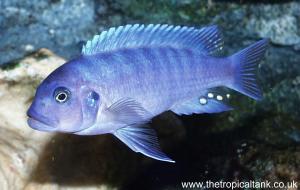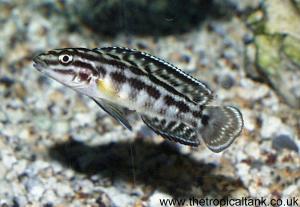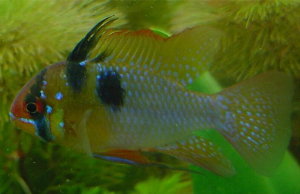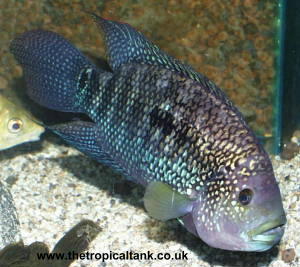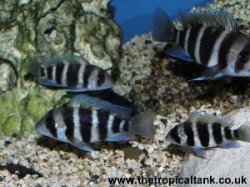
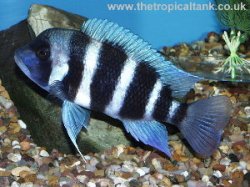
Left: Young Frontosa, Right: Adult female
Photos taken at Wharf Aquatics © Sean Evans
|
| Common name: | Frontosa, Humphead cichlid, 'Fronts' |
| Scientific name: | Cyphotilapia frontosa |
| Synonyms: | (none) |
| Size: | Up to approx 14" (35cm) for males and 10" (25cm) for females. |
| Origin: | Found in several areas of Lake Tanganyika, giving rise to a number of regional variants. |
| Tank setup: | A large tank (suggest 100 gallons/450 litres plus for a group), with plenty of open space.
Large smooth rocks can be used to make caves (make sure they are secure!), or alternatively, large ceramic or PVC pipes could be used. |
| Compatibility: | May eat smaller fish. Best kept with other large fishes which can hold their own but are
not overly aggressive. The open-water 'Haplochromines' from Lake Malawi are a good choice. |
| Temperature: | 24-27oC (75-81oF) |
| Water chemistry: | Hard and alkaline: pH 7.8-9.0, GH 12-20, KH 14-20 ideally, but at least 6. |
| Feeding: | In the wild, these fish are primarily piscivores (fish eaters). In the aquarium, this can be
provided for with baitfish such as whitebait, lance fish, silversides etc, and mussel, prawn/shrimp, etc. There is also a
range of suitable cichlid sticks and pellets available. |
| Sexing: | Although there are several indicators of gender in Frontosa, they are not clear-cut. Males tend to have
a larger nuchal hump on the forehead, but older females will also possess a hump. Males will tend to be larger and provide other
clues via their behaviour. However, this will not be much help in initially selecting juveniles. An experienced breeder/dealer
may be able/willing to 'vent' the fish, but do not expect reliable results from smaller juvenile fish! |
| Breeding: | Ideally, a breeding colony should be established with one male per 3-4 females. Other sub-dominant males
will usually be tolerated in groups occupying a large tank. These fish mature slowly, so patience is required to establish a breeding
colony - do not buy juvenile 'fronts' if you want a breeding project with quick results! Spawning is not as dramatic or aggressive as many
other cichlid species.
The female mouthbroods the young for a relatively long time period, about five weeks. Fry should be removed and raised separately. |
| Comments: |
Adult Frontosa are a very impressive sight in a large aquarium. A number of the regional variants are highly desirable to enthusiasts,
such as the 'Zaire blue' and 'Mpimbwe blue'.
|






